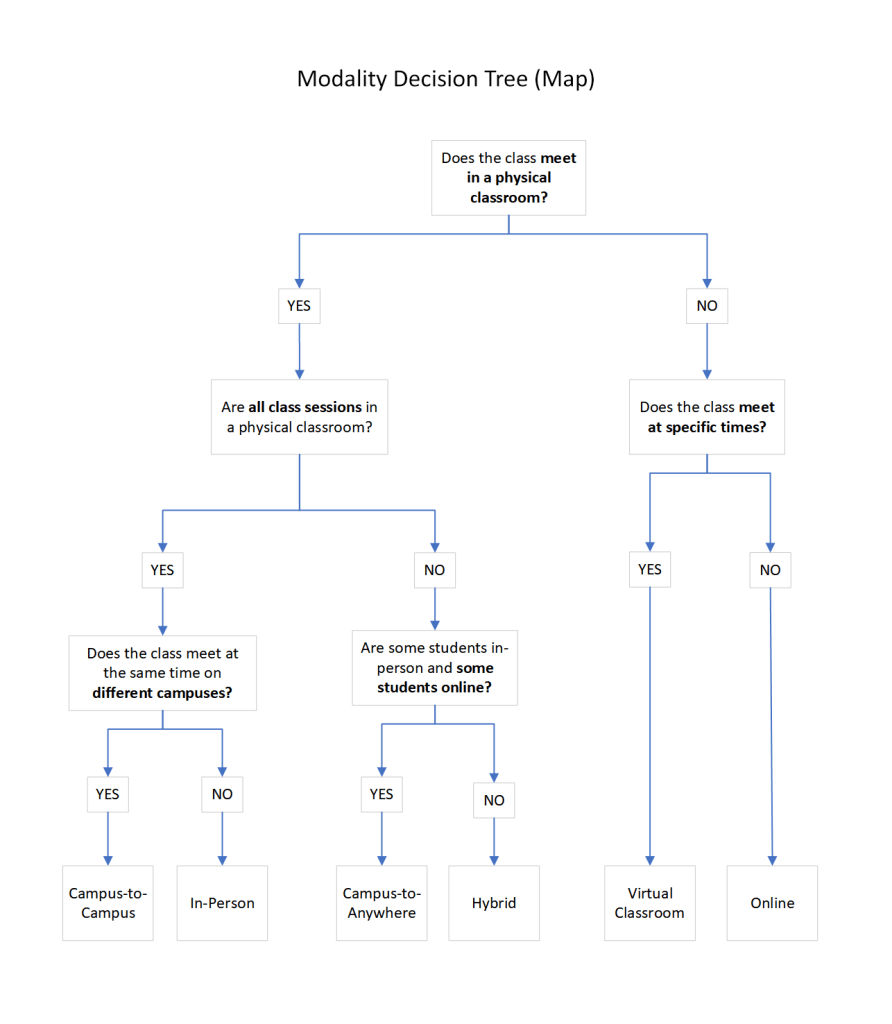Beginning in Summer 2024, there will be six teaching modalities at UW-Green Bay: in-person, online, virtual classroom, hybrid, campus-to-campus, and campus-to-anywhere. This guide is designed to help instructors understand the differences between these modalities by breaking them down into manageable categories.
Synchronous versus Asynchronous Work
One way to think about the various modalities is whether the majority of classwork is done synchronously (students can only participate by being in a space at a particular time) or asynchronously (students can participate on their own schedule). As an instructor, you may wish to ask yourself which works best for you.
Mostly synchronous work: in-person, virtual classroom, campus-to-campus, and campus-to-anywhere
A mix of synchronous and asynchronous work: hybrid
Fully asynchronous work: online
Necessary Technologies
As with synchronicity, different modalities sometimes require different technologies to support student learning. All courses, regardless of modality, should use Canvas to manage things like assignment due dates and grades. Some modalities, like online, also require the use of Canvas for content delivery (e.g., posting video lectures or readings), collaboration (e.g., online discussion boards), or assessment (e.g. online quizzes). Modalities in which some or all students are meeting synchronously but across different locations, like virtual classroom, campus-to-campus, and campus-to-anywhere courses, require the use of a web conferencing platform, usually Zoom. Courses with an in-person component may have in-classroom technology to contend with, such as projectors and document cameras. Instructors teaching campus-to-campus and campus-to-anywhere courses may require some additional training to use the special technology in these classrooms that allows instructors to connect with remote students and screen-share content from a variety of inputs.
Flow of Communication
Who communicates with whom and how is an important question to consider when selecting a teaching modality. Any format can accommodate multiple communication patterns, but it is useful to think about how the technology that supports the mode can also support the types of interactions you wish to have in your class.
Discussion-based classes and seminars may lend themselves to modalities that make it easier to facilitate student-to-student interaction, such as virtual classroom and in-person. Hybrid can also work for discussion-based courses if you “flip your classroom” — provide content and materials that students engage with asynchronously before a class meeting, such as readings and lecture videos, and then use class time for discussion and group work. While discussion can also work in campus-to-campus and campus-to-anywhere courses, keep in mind that facilitating class discussions across multiple locations requires extra attentiveness to ensure that all students can hear and participate equally.
Lecture-based courses can work in nearly any modality but lend themselves well to online courses. Although you can incorporate interactive elements like discussion boards, the majority of work that students do in an online course will be done independently and on their own schedule.
Overview of UWGB Modalities
The modality map below can help you learn the difference between the six teaching modalities at UWGB and select which is best for you.
Modality Decision Tree (Map) PDF version
